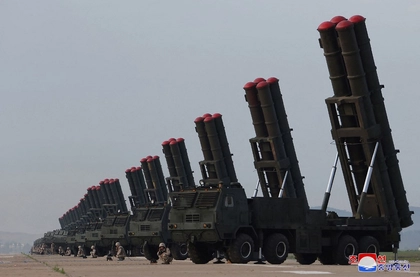In 2025, North Korea plans to deliver at least 150 KN-23 short-range ballistic missiles, as well as artillery shells and systems, to Moscow, according to Ukraine’s military intelligence chief (known as HUR), Kyrylo Budanov.
The artillery is being used to support both North Korean and Russian operations, while the missiles are strictly for Russian objectives, Budanov said in an interview with The War Zone, saying that North Koreans will also train Russians on all of these systems.
JOIN US ON TELEGRAM
Follow our coverage of the war on the @Kyivpost_official.

The head of Ukrainian intelligence added that North Korea might also send reinforcements in the form of infantry to the Kursk region in 2025.
“We don’t expect to see many new ground combat troops,” he added, however.
Over the past three months, North Korea has delivered approximately 120 M1989 “Koksan” self-propelled artillery systems with a 170mm caliber and 120 M-1991 multiple rocket launchers with a 240mm caliber to Russia. In the future, North Korea is expected to send at least the same amount of this equipment to the Russians, Budanov said.

Belarus’ Farcical Election, Part 1 – the Dictator’s Charade
North Korea is known to have an immense arsenal built up over decades for potential use along the DMZ in the event of a war with South Korea.
North Korean troops and weapons add new challenges for Ukraine. In Kursk, they are reportedly used in so-called “human wave” tactics, where large forces attack with minimal armored support.
Well before the first North Korean prisoners were captured, Budanov, on Oct. 18, had said that Pyongyang was preparing to send 11,000 troops to aid Moscow’s invasion of Ukraine.
Following the reports, Seoul’s National Intelligence Service (NIS) issued satellite images allegedly showing North Korean troops in Russia’s Far East prior to their deployments in Ukraine. Videos circulating on social media around the time also showed Korean-speaking soldiers in a Russian military base.
In January Ukrainian forces have captured two North Korean soldiers fighting alongside Russian troops in Ukraine’s Kursk region, marking the first confirmed instance of Pyongyang’s direct involvement in the war.
The soldiers, aged 20 and 26, were wounded during combat and are currently receiving medical treatment in Kyiv. During interrogations, one soldier revealed he was initially sent to Russia under the guise of military training.
You can also highlight the text and press Ctrl + Enter










